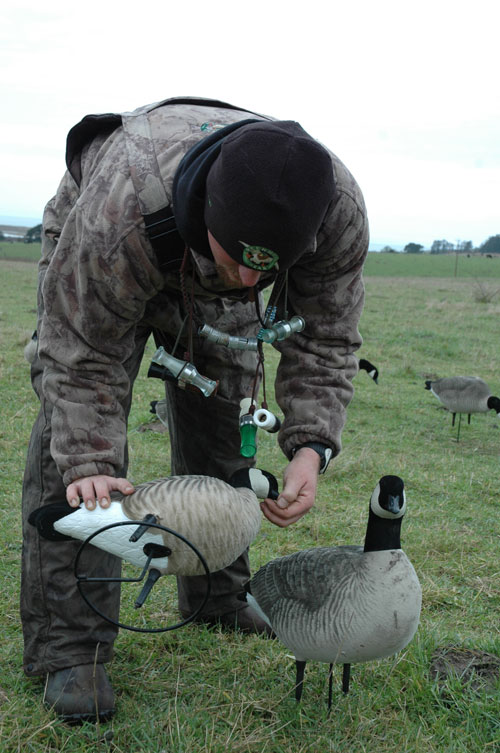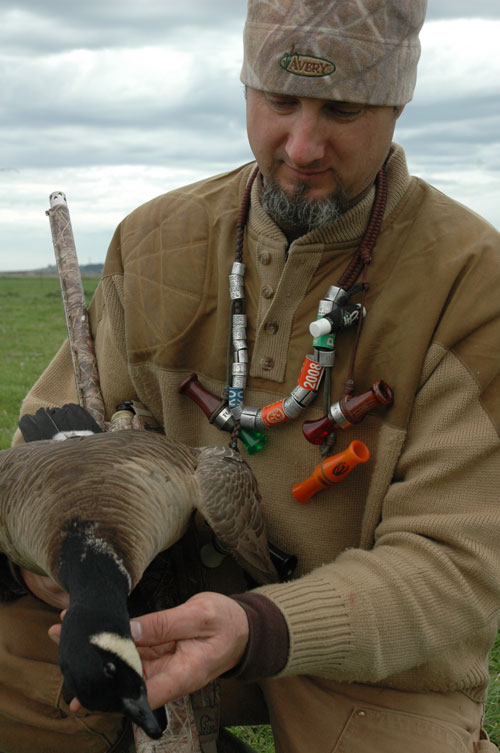Canvasbacks – Mississippi River

The Columbia River in eastern Washington holds tremendous numbers of canvasbacks, as can any of the Great Lakes. TIP – Cans are relatively species-specific when it comes to decoys; however, other divers such as redheads, bluebills and buffleheads will look hard at can blocks.
Goldeneyes – Snake River, Idaho
Every year in early January, my wife and I drive from our home in eastern Iowa west to Washington state on business; well, some business, with a whole lot of duck hunting thrown in for good measure. As we pass through Idaho, I’ve always been amazed at the number of birds on the Snake River, many of which are immediately recognizable from both a distance and at 75 miles per hour — the unmistakable tuxedo-esque plumage of drake goldeneyes. For those who haven’t hunted them, goldeneyes have few equals on the wing or on the wall. In terms of tablefare — no, they’re not teal or wood ducks, but breasted, sliced thin and seared in olive oil, they do make a wonderful stir fry.
Coastal Washington supports good populations of both Common and Barrow’s goldeneyes, the subspecies dependent upon the location. Eastern Lake Ontario, as well as the St. Lawrence Seaway, also are exceptional choices. TIP – Like cans, goldeneyes are species-specific when it comes to decoys. You don’t need many set to one side; six to 12 are plenty in most cases.
Harlequins – Coastal Washington
Coastal Washington is the only place in the Lower 48 where ’fowlers are permitted to take harlequins, and the limit is only one per year. Oregon gunners see blue ducks throughout the fall; so do hunters along the upper East Coast — but they’re off-limits. For those who haven’t seen harlequins up close, they’re beautiful. And their home turf — wave-washed cobblestone stretches of Pacific Northwest beachfront — is some of the most picturesque in the country. Captain David Drewry (peninsulasportsman.com) is the man to contact for more on this extraordinary hunting opportunity.
Alaska is the only other option if it’s a harlequin you seek. Yes, it’s more expensive than Washington, but the scenery and the variety of species you’ll encounter will make the trip a once-in-a-lifetime venture. TIP – Small (No. 5 or No. 6) shot is recommended if you’re looking for a bird to mount, but take larger stuff for scoters, goldeneyes and oldsquaws.
Eiders – Coastal Maine
My initial impression of coastal Maine was that of an old school black-and-white photograph, an image further substantiated with the appearance of the birds we sought that cold December morning — common eiders. A large sea-going fowl, eiders of both sexes are ruggedly handsome birds — the drakes, a stark black/white, and the hens, a soft dark mottled brown. Theirs is a world of wind and waves, of huge rock ledges and deep, bone-chilling waters. It is truly no world for the novice, much of the reason why our group was lead by Maine native Todd Jackson (seaduck.net) and his crew of experienced skippers.
Commons can be found as far south as New Jersey; however, the further north along the East Coast you hunt, the better for eiders. TIP – Eiders are cloaked in Kevlar, it would seem. Heavy charges of big (No. 1 or BBs) steel or a good tungsten-based load are highly recommended.
Scoters – Coastal Rhode Island
To the south of Maine, Captain Brian Rhodes (theswampers.com), a member of the Avery Outdoors Pro-Staff team, guns the waters of coastal Rhode Island for a variety of species, among them scoters. “Every year,” said Rhodes, “it’s different in terms of scoters, but during the 2008-09 season, I’ve never seen so many. In fact, we had several trips where my clients harvested what we call the Scoter Slam — white-wings, blacks, and surfs in one morning.” According to the captain, whose home turf includes Rhode Island and Block Island sounds, as well as Narragansett Bay, the days after Thanksgiving are the best for anyone searching for a scoter or three for the wall. Of special note for anyone traveling to Rhode Island to hunt waterfowl, all non-residents are required to present a valid Hunter Education Certificate prior to being issued their short-term hunting license; no exceptions.
Good scoter populations are found all along the upper East Coast, as well as the waters off of Washington, Oregon and northern California. TIP – Like eiders, which Rhodes also targets, scoters are tough customers. The same No. 1s or BBs that work for black-n-whites will work well for these heavily muscled birds.
Aleutian Canada geese – Humboldt and Del Norte counties, California
 In 1967, the Aleutian Canada goose — a miniature subspecies of the Canada clan — was listed by the U.S. Fish and Wildlife Service as an endangered species. The introduction of non-native predators, specifically Arctic and red fox, to the Aleutian’s breeding islands spelled disaster for the diminutive birds. Efforts by the USFWS over the next 30 years, however, resulted in Aleutian numbers climbing to the point to where in 1990, the subspecies was relisted as threatened; 11 years later, Aleutians were delisted entirely. Today, California offers carefully monitored hunting opportunities for these fascinating little geese during the fall and late winter. My wife and I had our second chance to hunt Aleutians in Humboldt County, CA, just south of Eureka in March of 2009, and all I can say is — to quote The Terminator — “we’ll be back”
In 1967, the Aleutian Canada goose — a miniature subspecies of the Canada clan — was listed by the U.S. Fish and Wildlife Service as an endangered species. The introduction of non-native predators, specifically Arctic and red fox, to the Aleutian’s breeding islands spelled disaster for the diminutive birds. Efforts by the USFWS over the next 30 years, however, resulted in Aleutian numbers climbing to the point to where in 1990, the subspecies was relisted as threatened; 11 years later, Aleutians were delisted entirely. Today, California offers carefully monitored hunting opportunities for these fascinating little geese during the fall and late winter. My wife and I had our second chance to hunt Aleutians in Humboldt County, CA, just south of Eureka in March of 2009, and all I can say is — to quote The Terminator — “we’ll be back”
This is a brief private-lands-only season for birds that have seen pressure since October of the previous year. Translation: The hunting is anything but easy. Some private lands are available for limited public use during the Aleutian-only season through the state’s SHARE (Shared Habitat Alliance for Recreational Enhancement) Program. For more information, visit the California Department of Fish and Game’s website at dfg.ca.gov
TIP – Make this your Aleutian mantra — Smaller decoys bag bigger geese, but big decoys don’t necessarily work on the little ones. Downsized Canada fakes, such as Avery’s FFD Lessers (averyoutdoors.com), are the ticket.






